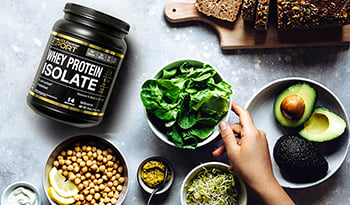What Is The Organic Food Diet?
DISCLAIMER:This blog does not intend to provide diagnosis...
- In this article:
- What Is Meant by Organic Food?
- How to Follow an Organic Diet
- Tips For Shopping Organic

Originally posted January 2018 / Updated February 2023
What Is Meant by Organic Food?
In 2002, the United States Department of Agriculture (USDA) established the standards of what a food labeled "organic" must meet. Organic certification standards are similar for those countries that have them. Organic food is produced without using synthetic pesticides or fertilizers.
Organic certification does not allow for use of sewage sludge as a fertilizer, crops that have been genetically modified, or foods that have been radiated. To be labeled organic food in the United States, a government-approved certifier inspects the farm to ensure the farmer follows all the rules necessary to meet USDA organic standards.
Organic certification includes produce and other foods, including meat, poultry, eggs, and dairy products. Foods from animals must be produced without antibiotics or growth hormones.
In the US, most organic foods provide the USDA Organic seal on the label, but such labeling is not required. If a product is fraudulently labeled "organic" in the US, it can result in severe fines for each violation.
How to Follow an Organic Diet
People who follow a purely organic diet choose to consume only foods that meet the certification standards or come with assurances that they have been grown without conventional fertilizers. Organic growing practices are generally regarded as being very beneficial for the environment as they produce less pollution than traditional farming and keep soil safe and healthy. These practices are good not only for the planet but also for people.
Eating a diet rich or exclusively in organic foods can directly impact a person's health. Some studies have indicated that a diet rich in organically grown fruits and vegetables may provide specific health benefits. And while the nutrient content of organically grown food is similar to conventionally grown foods, the organic varieties provide more health-promoting phytochemicals and fewer pesticides than conventionally grown ones. There are also nutritional advantages to organic meat and dairy products.1-3
Reading labels can help consumers find organic foods, and the USDA Organic certification seal can be a helpful identification tool. This seal can be used on organic whole foods, such as fruits and vegetables. It can also be used on multi-ingredient foods that contain 95 percent or more organic ingredients. Foods containing a lower organic percentage can reference organic ingredients on their labels, but they cannot bear the USDA seal.
No foods are expressly off-limits in a purely organic diet other than non-organic foods. People who follow an organic diet often also consume some conventionally grown food because some fruits and vegetables typically have lower levels of pesticides, or they may choose to avoid the fruits and vegetables grown with the highest pesticides.
Tips For Shopping Organic
Each year the Environmental Working Group, a nonprofit organization in the US, publishes two lists that can help select fresh fruits and vegetables based on pesticide contamination. The Dirty Dozen™ and the Clean Fifteen™, respectively, list the most and least pesticide-contaminated produce. These lists are based on data supplied by the USDA.
Here are these lists from the 2022 EWG data.
2022 Dirty Dozen:
- Strawberries
- Spinach
- Kale, collard, and mustard greens
- Nectarines
- Apples
- Grapes
- Bell and hot peppers
- Cherries
- Peaches
- Pears
- Celery
- Tomatoes
2022 Clean Fifteen:
- Avocados
- Sweet corn
- Pineapple
- Onions
- Papaya
- Sweet peas (frozen)
- Asparagus
- Honeydew melon
- Kiwi
- Cabbage
- Mushrooms
- Cantaloupe
- Mangoes
- Watermelon
- Sweet Potatoes
Other products to look for when following an organic lifestyle are organic supplements and herbs, bath and beauty products, and even home products. The more you can avoid the possible toxins in the products you consume, breathe in or expose to your skin, the healthier you and the rest of the planet will be.
References:
- Rahman SME, Mele MA, Lee YT, Islam MZ. Consumer Preference, Quality, and Safety of Organic and Conventional Fresh Fruits, Vegetables, and Cereals. Foods. 2021 Jan 6;10(1):105.
- Mie A, Andersen HR, Gunnarsson S, Kahl J, Kesse-Guyot E, Rembiałkowska E, Quaglio G, Grandjean P. Human health implications of organic food and organic agriculture: a comprehensive review. Environ Health. 2017 Oct 27;16(1):111.
- Crinnion WJ. Organic foods contain higher levels of certain nutrients, lower levels of pesticides, and may provide health benefits for the consumer. Altern Med Rev. 2010 Apr;15(1):4-12.
- EWG's 2022 Shopper's Guide to Pesticides in Produce™

 By Dr. Michael Murray, N.D.
By Dr. Michael Murray, N.D. 


